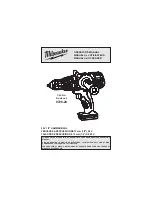
9
twisting action and avoid injury.
• DO NOT CLICK THE TRIGGER OF A
STALLED DRILL OFF AND ON IN AN
ATTEMPT TO START IT. DAMAGE TO
THE DRILL CAN RESULT.
• Minimize stalling on breakthrough by
reducing pressure and slowly drilling
through the last part of the hole.
• Keep the motor running while pulling
the bit out of a drilled hole. This will help
reduce jamming.
• Make sure switch turns drill on and off.
DRILLING IN WOOD
Holes in wood can be made with the same
twist drill bits used for metal or with spade
bits. These bits should be sharp and should
be pulled out frequently when drilling to
clear chips from the flutes.
DRILLING IN METAL
Use a cutting lubricant when drilling metals.
The exceptions are cast iron and brass
which should be drilled dry. The cutting
lubricants that work best are sulfurized
cutting oil or lard oil.
DRILLING IN MASONRY
Use carbide tipped masonry bits. Refer to
Drilling section. Keep even force on the
drill but not so much that you crack the
brittle material. A smooth, even flow of dust
indicates the proper drilling rate.
MAINTENANCE
WARNING:
To reduce the risk of
serious personal injury, turn tool off and
disconnect tool from power source before
making any adjustments or removing/
installing attachments or accessories.
Use only mild soap and damp cloth to clean
the tool. Never let any liquid get inside the tool;
never immerse any part of the tool into a liquid.
IMPORTANT: To assure product SAFETY
and RELIABILITY, repairs, maintenance
and adjustment (other than those listed
in this manual) should be performed by
authorized service centers or other qualified
service personnel, always using identical
replacement parts.
ACCESSORIES
Recommended accessories for use with
your tool are available from your local dealer
or authorized service center. If you need
assistance regarding accessories, please
call: 1-800-544-6986.
WARNING:
The use of any accessory
not recommended for use with this tool could
be hazardous.
The RBRC
®
Seal
The RBRC® (Rechargeable
Battery Recycling Corp oration)
Seal on the lithium-ion batteries
(or battery packs) indicates
that the costs to recycle these batteries
(or battery packs) at the end of their
useful life have already been paid by
BLACK+DECKER. In some areas, it is
illegal to place spent lithium-ion batteries in
the trash or municipal solid waste stream
and the Call 2 Recycle® program provides
an environmentally conscious alternative.
Call 2 Recycle, Inc., in cooperation with
BLACK+DECKER and other battery
users, has established the program in the
United States and Canada to facilitate the
collection of spent lithium-ion batteries.
Help protect our environment and conserve
natural resources by returning the spent
nickel cadmium, nickel metal hydride
or lithium-ion batteries to an authorized
BLACK+DECKER service center or to
your local retailer for recycling. You may
also contact your local recycling center for
information on where to drop off the spent
battery. RBRC® is a registered trademark
of Call 2 Recycle, Inc.
This Class B digital apparatus complies
with Canadian ICES-003.
This device complies with part 15 of the
FCC rules. Operation is subject to the
following two conditions: (1) This device
may not cause harmful interference, and
(2) this device must accept any interference
received, including interference that may
cause undesired operation.
NOTE: This equipment has been tested
and found to comply with the limits for
a Class B digital device, pursuant to
Part 15 of the FCC Rules. These limits
are designed to provide reasonable
protection against harmful interference in
a residential installation. This equipment
generates, uses and can radiate radio
frequency energy and, if not installed and
used in accordance with the instructions,
may cause harmful interference to radio
communications. However, there is no
guarantee that interference will not occur in
a particular installation.
If this equipment does cause harmful
interference to radio or television reception,
which can be determined by turning
the equipment off and on, the user is
encouraged to try to correct the interference
by one or more of the following measures:
• Reorient or relocate the receiving
antenna.
• Increase the separation between the
equipment and receiver.
• Connect the equipment into an outlet on
a circuit different from that to which the




























